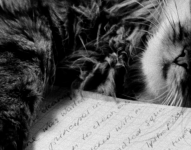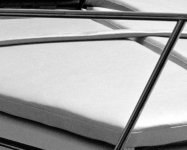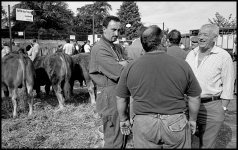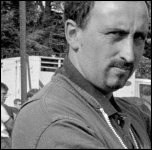thorsten
rf explorer
Finally I developed my first 35mm-film today (after a long digital time). Though I've obviously been a bit inattentive (scratched emulsion on some negatives) I liked the results with HP5+ in ID-11 (standard times). But I disliked the results my scanner gave me! My Epson 4990 has been okay with 6x6 color negatives, although the quality with b+w wasn't too good even in this medium format. But with smallframe I'm not content, even more when thinking that I plan not to use a darkroom anymore but print the scanned negatives with an Epson 2400.
So I decided I have to go with a dedicated film scanner. Since I can't afford a scanner that costs as much as a car (so no Imacon or drum scanner), Nikon seems to be the (only?) answer. I still have 2 questions and hope to get some answers of you:
1. I _read_ that Nikon pronounces the film-grain in an ugly way. I will shoot b+w 90%, another 10% color-negatives. Is Nikon a good choice for b+w or won't the results be better compared to my Epson 4990?
2. Which one to get? I could afford the Super Coolscan 5000. Does this offer better quality than the Coolscan V ?
Thanks a lot for any help.
Kind regards,
So I decided I have to go with a dedicated film scanner. Since I can't afford a scanner that costs as much as a car (so no Imacon or drum scanner), Nikon seems to be the (only?) answer. I still have 2 questions and hope to get some answers of you:
1. I _read_ that Nikon pronounces the film-grain in an ugly way. I will shoot b+w 90%, another 10% color-negatives. Is Nikon a good choice for b+w or won't the results be better compared to my Epson 4990?
2. Which one to get? I could afford the Super Coolscan 5000. Does this offer better quality than the Coolscan V ?
Thanks a lot for any help.
Kind regards,
M
Magnus
Guest
Any dedicated film/slide scanner is not good for B&W. One might be better than the other but only slightly.
I had the same dillema as you and managed to solve the greatest aggrivation by taking really good care of my negatives, I bought a special drying cabinet and tiled my darkroom on all six surfaces. This helps a great deal but scanning B&Won my 5000 still proves hard, but certainly do-able. From other threads I have heard that Monolta is better for B&W but I don't have any experience with that, you might want to check it out prior to purchasing a Nikon V or 5000
I had the same dillema as you and managed to solve the greatest aggrivation by taking really good care of my negatives, I bought a special drying cabinet and tiled my darkroom on all six surfaces. This helps a great deal but scanning B&Won my 5000 still proves hard, but certainly do-able. From other threads I have heard that Monolta is better for B&W but I don't have any experience with that, you might want to check it out prior to purchasing a Nikon V or 5000
thorsten
rf explorer
Thanks for your reply, Magnus. This doesn't sound too encouraging. Will I have an increase at all with a film scanner in comparison with my Epson 4990 flatbed?
JoeFriday
Agent Provacateur
you'll see a noticeable, but not huge, improvement between the 4990 and something like a Coolscan V on 35mm film.. but I'm not sure it would be enough to justify the cost
sunsworth
Well-known
Thorsten, I've scanned hundreds of rolls of b&w film on a Coolscan III, then a Minolta ScanDual II and now a Nikon Coolscan V. If you can afford it buy a dedicated film scanner.
I'd show you an example, but I don't seemed to be allowed to upload an image.
Steve
I'd show you an example, but I don't seemed to be allowed to upload an image.
Steve
thorsten
rf explorer
Thanks again for your answers.
Would the quality a Coolscan V gets out of a b&w film be enough for big prints with a nice Epson 2400 printer?
Would the quality a Coolscan V gets out of a b&w film be enough for big prints with a nice Epson 2400 printer?
sunsworth
Well-known
Thorsten, yes without any problem if the negative was good enough.
Steve
Steve
ffttklackdedeng
Registered User
Thorsten,
the 5000 won't be noticably better (regarding the result quality) than the V, it has 16 vs 14 bit depth (according to the specs) but it is faster and is capable of scanning more than 6 frames / 1 transparency at a time (if you like to spend another few hundreds on the adapters)
I think you _will_ get much better results than with a flatbed, if 10times enlargment vs 7times enlargement is much of a difference for you
regards, Robert
the 5000 won't be noticably better (regarding the result quality) than the V, it has 16 vs 14 bit depth (according to the specs) but it is faster and is capable of scanning more than 6 frames / 1 transparency at a time (if you like to spend another few hundreds on the adapters)
I think you _will_ get much better results than with a flatbed, if 10times enlargment vs 7times enlargement is much of a difference for you
regards, Robert
aad
Not so new now.
I think for black and white a film scanner can be less satisfying than an Epson 4xxx-noise is more difficult at times.
sunsworth
Well-known
aad said:I think for black and white a film scanner can be less satisfying than an Epson 4xxx-noise is more difficult at times.
Is that based on actual experience of what you've read on the web?
Steve
aad
Not so new now.
Based on my two scanners and about 200 rolls of film. My Scan Dual IV may be a touch sharper, maybe not, on black and white. I tend to prefer the Epson for that.
On color negatives, it's easier to get good results from the Minolta. On slides, no comparison-Minolta all the way.
On color negatives, it's easier to get good results from the Minolta. On slides, no comparison-Minolta all the way.
Oliver
Member
I'd take a hard look at the Minolta. I used a Nikon 4000 dpi and would sometimes see grain aliasing. I've never used the Minolta myself, but I've heard a few B&W fans say they love it and that they get better results with it. I mostly scan slides and for that the Nikons are very good. One more thing to bear in mind, the dust removal features of most scanners uses an infrared scan. This doesn't work with B&W or Kodachrome, so you won't get that benefit on your silver films.
As for flatbeds, as good as the Epson is supposed to be, you'll get better results from a film scanner. However, if you are only scanning for web/computer use, then all of these scanners will do great for you.
Best of luck with whatever you decide.
As for flatbeds, as good as the Epson is supposed to be, you'll get better results from a film scanner. However, if you are only scanning for web/computer use, then all of these scanners will do great for you.
Best of luck with whatever you decide.
ed1k
Well-known
I bought KM DImage Scan Dual IV for B&W and I like this scanner. Though I do traditional printing and use scanned images for archival purposes and web presentation. Also scanner and photoshop play important role to evaluate negative and it's significantly shorten my darkroom time. I am sure it is good enough for up to 30x40 cm prints. Yes, you will see the grain, but traditionally printed photo with such enlargment will show grain too.
Reasons I bought Konica-Minolta: it was 2 times cheaper than cheapest Nikon. It doesn't have IR dust&scratch remover, but I do mostly B&W and it wouldn't work with silver film anyway.
Let me know if you need some examples. I can't compare with any other scanner. My flatbed scanner, HP something, with slide adapter produces pure crap not worth for comparison. I heard that Epson isn't bad at all... May be you need some learnings of your Epson to operate it manualy and reasonable for B&W. I scan everything manually with my KM, because if negative is manipulated, just inverted and autoleveled, I lose some information for my evaluations, for example dinamic range and curve...
Eduard.
Reasons I bought Konica-Minolta: it was 2 times cheaper than cheapest Nikon. It doesn't have IR dust&scratch remover, but I do mostly B&W and it wouldn't work with silver film anyway.
Let me know if you need some examples. I can't compare with any other scanner. My flatbed scanner, HP something, with slide adapter produces pure crap not worth for comparison. I heard that Epson isn't bad at all... May be you need some learnings of your Epson to operate it manualy and reasonable for B&W. I scan everything manually with my KM, because if negative is manipulated, just inverted and autoleveled, I lose some information for my evaluations, for example dinamic range and curve...
Eduard.
ed1k
Well-known
ed1k
Well-known
One more example, last for today. Just different lens and different light. Film was the same, AGFA APX100; processing was similar (except this one was processed @26C because it was hot in TO); and same KM scanner.
Here is full frame
Eduard.
Here is full frame
Eduard.
Attachments
aad
Not so new now.
You could search out Shutterflower's scanner comparison-a lot on this forum and he set up a site with multiple scanners and a few sets of sample negatives and transparencies.
sunsworth
Well-known
thorsten
rf explorer
Steve and Eduard, I thank you a million for these beautiful examples. I think I'll go with the Coolscan V. Steve, your example looks miles ahead of the results my Epson gives me. I think that this isn't due to lack of my ability for scanning since I scanned a lot of mediumformat negatives with the Epson and got pretty nice results. Minolta really isn't an alternative since it is impossible to find new ones (with warranty!) here in Germany.
All the others: Thank you, too!
All the others: Thank you, too!
Imagestreet
Member
If you are prepared to shoot only chromogenic film (XP2, Portra B&W, etc) the Nikon 5000 ED is great. Chromogenic B&W film has the orange layer that allows you to use ICE, DEE, etc and saves you a lot of time in post scan Photoshop. I've been very happy with mine.
martin-f5
Well-known

on the other side you have to find out wich scannersoftware is the best one to use.
We have two minoltas here and use ed hammricks vuescan for both, my "old" minolta dimage scan dual II works pretty well with it
Share:
-
This site uses cookies to help personalise content, tailor your experience and to keep you logged in if you register.
By continuing to use this site, you are consenting to our use of cookies.




